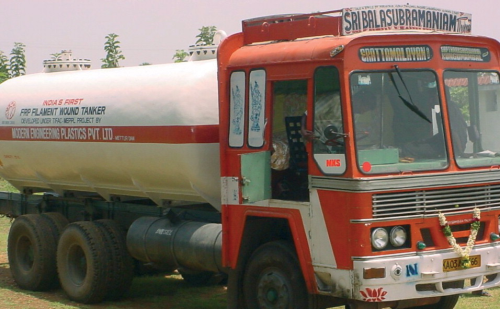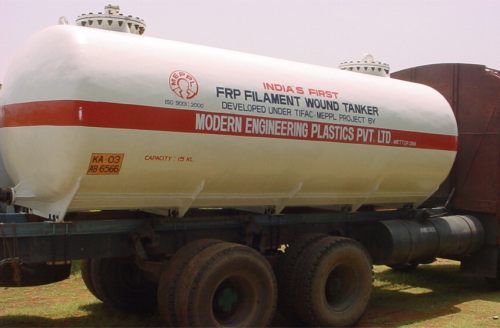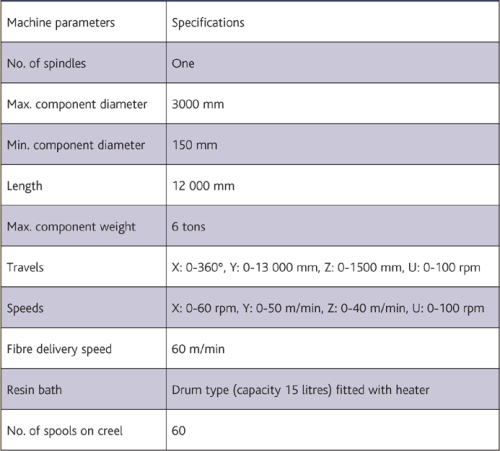


In India, road tankers are typically usd for the transportation of acids, alkalis, milk, petroleum products, edible oils, drinking water etc. Traditionally, metallic tankers of cylindrical or ellipsoidal cross section have been used for carrying such liquids. For corrosive liquids like acids or alkalis, the mild steel containers require a protective rubber lining on the inner wall. The initial rubber lining lasts only for four years and the tanker life can further be increased by two more years by relining them. This causes operational outage for steel tankers and adds to their maintenance cost. For tankers used for transporting water, rusting on the inner wall results in contamination of the water.
Glass fibre reinforced plastic (GRP) road tankers are ideal for transportation of corrosive liquids due to their low weight and corrosion resistance. While such containers have been in use extensively in other countries, their application did not pick up in India, mainly due to the lack of good design, technological capability and manufacturing facility in the country. On assessing the merits and market potential of such composite tankers over the conventional ones, a project for the design and development of composite road tankers using the filament winding technique was initiated by the Advanced Composites Programme of the Technology Information, Forecasting & Assessment Council (TIFAC) with an industry partner, Modern Engineering & Plastics Pvt Ltd, of Mettur (Tamil Nadu), and technology support from consultant NGN Composites, Chennai. The technology consultant carried out the mechanical and structural design of the composite tankers keeping in view the safety, functionality and durability requirements along with the design of the collapsible mandrels. NGN Composites also assisted in filament winding of the tankers and designed the tanker mounting mechanism on the vehicle chassis.
Prototype
India's first prototype filament wound composite road tanker with typical cross section for horizontal mounting on truck was successfully developed under this project. The prototype tanker has a capacity of 15.12 kl, a length of 5.70 m, width of 2.10 m and height of 1.60 m. It weighs 1.16 tonnes. A 12 mm thick filament wound composite layer was provided on a 2.50 mm thick resin-rich chemically passive liner to give a total thickness of 14.50 mm for the tanker wall. A net weight saving of about 1 tonne could be achieved in the case of a composite tanker as compared to a steel one of identical capacity.
An increased tanker length up to 6.55 m could be accommodated on the same vehicle chassis; this would enhance its carrying capacity to about 17 kl of water to garner the advantage of weight savings by using composites. The added capacity would directly benefit the transporters with better operational economics.
Filament wound composite tankers would be structurally superior with consistent product quality and reproducibility compared to the ones fabricated by the hand lay-up technique. The winding process also helps make the main shell and end domes in one integrated operation. The winding angle and thickness of filament wound layers are based on application and load requirement.
The innermost layer of the wall could be made chemically resistant by using either thermoplastic or thermoset liners. The thermoplastic liner could be of polyvinyl chloride (PVC), polypropylene (PP), poly(vinylidene fluoride) (PVDF) or polytetrafluoroethylene (PTFE), depending upon the chemicals to be handled. The thermoset barrier may consist of a gel-coat with surface veil mat and two to four layers of chopped strand mat (CSM) with antistatic additives added to the resin. A resin system of isophthalic, bisphenol, vinyl ester or epoxy could be used depending on the chemicals handled and the structural performance required. While vinyl ester would be suitable for a tanker designed for the transportation of caustic soda, isophthalic resin could be used for a tanker carrying water.
Two ‘anti-sloshing’ perforated baffles, placed at 850 mm apart from the centre, were provided inside the tanker shell with a passage cutout to reduce pressure in the longitudinal direction that occurs during sudden acceleration and deceleration of the truck. The tanker is also equipped with suitable nozzles for inlet, outlet and overflow of liquids. Two manholes of 500 mm diameter openings were provided at the top. The tanker could be mounted horizontally on the truck supported on six saddles, which are at a distance of 1 m from each other. The saddles were fastened to the tanker wall in a manner such that they can withstand the peel failure that may occur due to sudden acceleration. A comprehensive Code of Practice for design, manufacturing, prototype testing and evaluation of composite road tankers has been formulated after receiving inputs from various user agencies and others in order to arrive at the appropriate quality norms. The safety factor has been appropriately considered as per the various provisions of BS-4994 for composite vessel design since no separate standards are available for road tankers.
A 4-axes CNC filament winding system developed indigenously by CNC Technics, Hyderabad, was used for helical winding on the cylindrical portion and polar winding for the end domes. CADFil software was used for controlling the winding process. A technological challenge was posed by the polar winding of the end domes with typical elliptical cross section. After several rounds of winding trials, the process was perfected on establishing the compatibility between the software and the winding machine. The length of carriage traverse for the filament-winding machine has been chosen so as to facilitate manufacturing of larger sized railway tankers in future.
The general specifications of the 4-axes horizontal bed filament winding system used in the project are shown in Table 1.
An attractive proposition
Even with the marginally higher initial cost, the composite road tanker works out to be an economically attractive proposition based on its superior life cycle of 15 years with zero maintenance, compared to only six years for the rubber-lined steel tanker. The additional carrying capacity of the composite tanker makes it even more cost effective.
On average, 200-250 tankers for carrying caustic soda and hydrochloric acid (HCl) and 20 000 water tankers are currently manufactured every year in India. The filament winding system at Modern Engineering, Mettur, has an installed capacity for producing about 300 tankers per year, which is only a small fraction of the total requirement. The winding machine could be used for developing tankers for other applications such as for transportation of edible oil, chemicals etc.
The collaborative efforts by TIFAC and Modern Engineering Plastics have led to the development of a new composite application in India by an automated filament winding process. This step is expected to go a long way towards catering to the demands and aspirations of a rapidly industrialising country.






